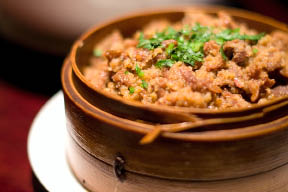Braised Wakuai Fish
Braised Wakuai Fish
This sumptuous delicacy has a history that can be traced back over 400 years. It is said to have first appeared in a story by Tan Yuanchun (1586-1637), a renowned Ming Dynasty writer and essayist.
|
 |
Tan was born in Jingling (today's Tianmen, Hubei Province) in central China. He founded the Jingling School of literature together with Zhong Xing, another writer of high regard. Through this school they vehemently opposed the then-prevalent school of thought that sought to revitalize the ancient writing style. They advocated freedom of expression and individuality in writing, and their efforts contributed to the continued development of Chinese essay writing.
As for Braised Wakaui Fish, the story goes something like this. One day, Tan invited Zhong Xing to his house for a feast. Tan planned to prepare herring. Cleaning and preparing the fish, Tan remarked to himself, "Why, with its tail and head removed, this herring rather resembles a xylophone!" Inspired by the thought, Tan cut slits along the sides of the fish following the line of its ribs and then braised it with wine. Zhong, who had stood watching this preparation, joined Tan in exclaiming, "A herring as a xylophone, what a good image it is!"
The cooked fish in all its glory was set on the table, but neither writer was willing to be the first to spoil its beauty by taking a bite. They decided to at least name the dish before eating it. Tan naturally wanted to call it "braised xylophone fish," while Zhong insisted that it actually more closely resembled wakuai, roof tiles, and hence should be named wakuai fish. They didn't succeed in settling the matter before their rumbling stomachs got the better of them.
Later, as this story and its dish became more widely known, more people tended to agree that when fully prepared the fish more closely resembled roof tiles. The name Braised Wankuai Fish stuck.
Ingredients: herring without head and tail, vinegar, black edible tree fungus, salt, rice wine, sugar, soy sauce, eggwhites, minced ginger, sectioned scallion, cooked lard, starch and pork broth.
Cooking procedures: first clean the herring, making slashes at a 45-degree angle along the length of the body. Rub in salt and marinate in rice wine. Next, place lard in a pan and fry on a hot stove until almost boiling. Place the herring into the pan and fry for three minutes. When fish turns golden in color, remove and drain excess lard. Turning burner to mid-heat, place minced ginger and then broth, black edible tree fungus, soy sauce, vinegar, sugar in with fried herring and braise for five minutes. When the liquid becomes thick, add wet starch for further thickening. Finally, sprinkle with diced scallion, and the dish is ready to be served.
Prepared in this manner, the herring is tender and fresh with a slightly sweet and sour taste.
Services
Economy
- Eco-agriculture and Eco-tourism Power Nanchang’s Green Development
- Balance Environmental Protection and Economic Prosperity – Nanchang Looks to European Technology for Green Development
- Sustainable Growth Requires Wiser Energy Use
- Chinese Economy: On the Path of Scientific Development
- China's Economy over the Last Ten Years

